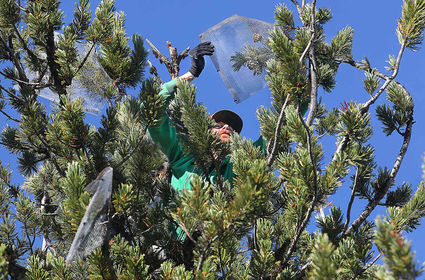Pine cone collection supports future forest growth
October 8, 2020
Pine cones are collected year-round by people to make garland, holiday wreaths, centerpieces and floral arrangements, but pine cones are also vital to the replenishment of conifer trees. Members of the Forest Service's Plains Tree Improvement Area (TIA) in Plains are working to ensure that happens.
Like a lot of boys, Riley Dopler liked to climb trees, but he probably didn't think he'd still be climbing at age 41 - and get paid to do it. Dopler, a Genetic Resource Forester, has been manager of the 123-acre TIA - also known as the "tree farm" - for just over a year and a member of the Forest Service for 16 years. As part of the Forest Service Genetic Restoration Program, the TIA provides pine cones to the Forest Service's nursery in Coeur d'Alene, Idaho, which in turn provides replacement trees in northern Idaho and all of Montana, including sending back young trees to plant at the TIA.
The Plains TIA, located along Highway 200 just west of town, has just over 7,500 trees of five different species - Ponderosa pine, Douglas fir, western larch, lodgepole pine and whitebark pine. The TIA usually hires contractors to collect the cones from its trees for the Idaho nursery, but sometimes the Forest Service staff members themselves have to take to the woods to get cones. That's when Dopler's childhood tree climbing skills come in handy, he said.
David Deroulhac and his wife, Liz McNair, along with their son Pinyon, all of Utah, were contracted in early September to pull cones from the farm's Ponderosa pines, the only other species the TIA collected this year. It took the trio about a week to retrieve 120 bushels of pine cones, which Dopler said was an estimated 1.5 million seeds bound for Coeur d'Alene. Dopler and Scott Palmer, who also works at TIA, made several trips by truck with burlap bags of cones, which had to be rotated and turned over daily prior to transport to keep the cones from getting moldy. The TIA didn't get any pine cones last year due to insect infestation, said Dopler, but in 2018 they plucked 60 bushels of Douglas fir and 165 bushels of Ponderosa pine. Prior to transporting the cones, Dopler and Palmer inspect them for insect infestation and disease.
"The Plains TIA has a successful cone crop history that supports reforestation efforts across all of Region One," said Dopler. The Forest Service is considered the "custodian of the forest" and its Restoration Program keeps the woods from disappearing, which is why each year the pine cones are collected and sent to the Idaho nursery.
Research on tree species genetics began in the 1950s. The Forest Service bought the land for the TIA in 1991 in an effort to produce quality seeds for future trees. The Plains tree farm is divided into 23 sections with trees that range from year-old saplings to 20-foot-tall trees that are some 120 years old. Most of the trees at the TIA are grafted at the Coeur d'Alene Nursery, which means the root stock and bottom of the tree could be only a couple of years old, but the top part might be 25 years old.
"I have always had a passion for reforestation," said Dopler, who added that he has a direct role in planting over 500,000 trees in his career with the Forest Service. "It is exciting to now be part of these efforts on a much broader scale providing future forests for future generations," added Dopler.
Although the TIA has about 260 whitebark pines at the tree farm, they are only five years old and not mature enough to bare cones, according to Dopler, a certified silviculturist since 2017 and a 2002 University of Montana graduate with a Bachelor of Science degree in forestry. Dopler said the whitebark pine is a "species of concern" that has been impacted mostly by blister rust over the years. Dopler noted that the TIA's whitebark pines are having a tough time because the tree farm is situated at a much lower elevation than the normal native environment of that species.
"They're an important food source for grizzly bears in the spring," said Plains/Thompson Falls Ranger District member Mikey Church, who added the higher elevation species is also vital to birds. Because the whitebark pine has been considered for the endangered species list and Dopler's team is unable to get cones from the TIA's trees, they headed to the woods to get the cones.

Ed Moreth
PROCESSING CONES – Riley Dopler (right) and Scott Palmer of the Forest Service's Plains Tree Improvement Area (TIA) take a look at a pile of Ponderosa pine cones collected at the TIA.
In early June, Dopler and Palmer put flexible metal cages on two whitebark pine trees at Pat's Knob and at Cinnabar Ridge near Stevensville in an effort to keep birds and squirrels from getting to the pine cones before the team could. The cones also have to be nabbed before they fall to the ground, open and lose their seeds. Not everyone at the Plains/Thompson Falls Ranger District can ascend trees; they must be certified, which involves a weeklong course provided by the Forest Service. The ranger district has two certified climbers, Dopler and Church, who both went on the whitebark pine excursion last week to Pat's Knob because Forest Service policy dictates there must be two certified climbers for safety purposes, although only Dopler did the climbing.
The Pat's Knob operation took only about 20 minutes once the team drove up the mountain and hiked to the site of the tree. The designated whitebark pine tree has been used for cone retrieval for the past nine years, said Palmer, who's been with the Forest Service for 10 years and plans to become a certified climber next year. Eight cages had been placed in different spots 45-50 feet up in the tree. One cage had come off and fallen, but it still had closed cones inside. In all, the team collected 18 pine cones from Pat's Knob.
Two days later, Dopler, Palmer and Max Wheeler, a certified climber from the Missoula Ranger District, retrieved 14 cones from a whitebark pine tree at Cinnabar Ridge. It took only about 20 minutes for Dopler to get the cones, marking the end of the cone collecting for the year.





Reader Comments(0)